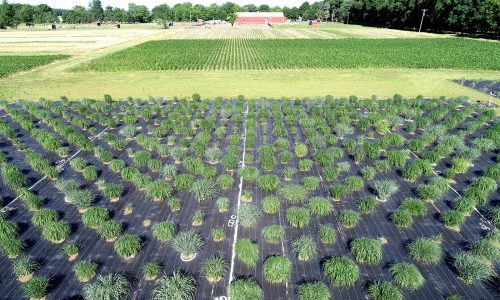Several research groups at HudsonAlpha Institute for Biotechnology are passionate about producing crops that can be used as fuel to create clean and sustainable energy for our planet. And now with the help of a newly awarded Department of Energy (DOE) grant, they can move one step closer to this goal.
The grant is part of a DOE project that will provide $68 million in funding over five years for basic research aimed at making more productive and resilient crops that can be used to produce fuel, called biofuel. Material from these crops, referred to as biomass, can be harvested and converted into liquid biofuels for use in transportation, or as energy for heat and electricity. Biofuel represents an important alternative to fossil fuels because it is a renewable, sustainable, and carbon neutral source.
Faculty Investigator Jeremy Schmutz of HudsonAlpha is a member of a team of researchers from across the United States that have been working together for more than a decade to genetically characterize and improve the biomass production of switchgrass. The collaborative research team is led by Thomas Juenger, PhD, of The University of Texas at Austin. Kankshita Swaminathan, PhD, of HudsonAlpha, joins the group to bring her team’s expertise in plant gene editing to the project.
“One of the most exciting aspects of our project is the diverse research perspectives on the team – a group that includes ecologists, evolutionary biologists, genomic and data scientists, microbial ecologists, physiologists and plant breeders,” Juenger said. “The broad perspectives provided by the team have been critical for developing creative solutions to improving switchgrass.”
Switchgrass (pictured below) is a grass that grows in much of North America. It is commonly used for livestock feed and erosion control. Switchgrass is a promising biofuel candidate because it has several desirable qualities such as deep roots that allow it to access nutrients easily from a variety of soils, and a higher tolerance for extreme water conditions, such as drought or prolonged periods of rain.
There are several varieties of switchgrass based upon the climate and environment in which they grow. For example, the southern lowland switchgrasses are tall and thick-stemmed, while the northern upland switchgrasses are short and thin-stemmed.
For biofuel production, tall and hearty switchgrass is desirable to produce the most biomass per plant. The research groups aim to produce a variety of switchgrass that is high-producing like the southern plants but has cold tolerance like the northern plants.
By breeding switchgrass that can thrive across different climates, the research group hopes to meet the challenge of creating a biofuel crop that is not only sustainable and clean but can also be grown on lands that are not traditionally useful for growing food. The ability of a biofuel crop to grow on otherwise uninhabitable land is important in the quest to increase biofuel crop production without jeopardizing land used for commercial farming.
Planting switchgrass in common gardens at ten diverse sites across the United States allows the research group to study how genetics and the environment interact. This helps the researchers determine the genes or genetic changes responsible for desirable switchgrass traits. Such traits include high biomass production, cold tolerance, sustainability, and a high success rate of plant establishment from seeds.
“We hope to be able to solve long standing issues with switchgrass crop improvement by applying our large-scale genomic efforts,” Schmutz says. “Improved switchgrass varieties will bring greater cold tolerance and increased yield for biofuel feedstocks for this highly sustainable perennial crop.”
The group will identify genes that confer these key traits in switchgrass and use Swaminathan’s expertise in targeted editing and plant breeding to make varieties of switchgrass that will produce the most biomass yet will survive in colder climates.
“Over the last decade this team has used the latest technology in genomics to explore the effect of genetics and environment in switchgrass and have identified genes that likely influence many desirable traits,” says Swaminathan. “It is a really exciting time to test these hypotheses using recent advances in plant biotechnology and genome editing. This will allow us to explore the precise function of genes of interest and help inform directed breeding for more resilient, high yielding plants.”
Researchers from the following institutions are also Co-PIs and Collaborators on the UT Austin led DOE grant: University of Missouri, Argonne National Laboratory, Washington State University, Michigan State University, Texas A&M AgriLife Research, USDA-ARS, University of Florida, South Dakota State University, National Renewal Energy Lab, Ladybird Johnson Wildflower Center, USDA-PMS, Oklahoma State University, DOE Joint Genome Institute, Colegio de Postgraduados (Mexico), Inst. Nac. de Investigaciones Forestales, Agrícolas y Pecuarias (Mexico), International Maize & Wheat Improvement Center (Mexico).

